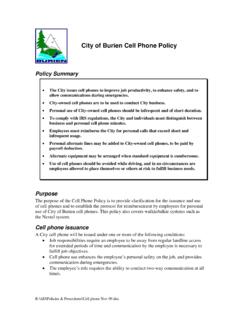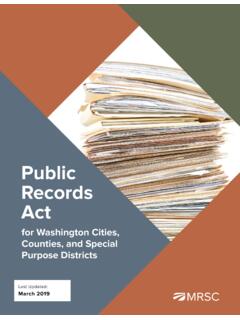Transcription of Local Ordinances - MRSC
1 Local Ordinancesfor Washington Cities and CountiesLocal Ordinances for Washington Cities and CountiesCopyright 2016 by MRSC. All rights reserved. Except as permitted under the Copyright Act of 1976, no part of this publication may be reproduced or distributed in any form or by any means or stored in a database or retrieval system without the prior written permission of the publisher; however, governmental entities in the state of Washington are granted permission to reproduce and distribute this publication for official Fourth Avenue, Suite 800 Seattle, WA 98121-1280(206) 625-1300(800) 2015$30 PrefaceThis publication has been prepared to assist Washington county, city, and town officials in the drafting and adoption of Ordinances , resolutions, motions, and related 1 ordinance Drafting Techniques and Requirements 3 Numbering 3 Title 4 Recitals or Whereas Clauses 5 Enactment Clause 7 Statement of Purpose 7 Definition Section 8 Provisions Establishing Administrative Units 9 Substantive Provisions 9 Penalty Provisions 9 Civil Recovery 10 Effective Date 10 Repeal 12 Amendment 13 Saving Clause 14 Severability Clause 14 Short Title 14 Signatures 15 Style 16 Gender Neutral and the Use of He and She 16 Use of Shall and May 17 Duplication of Words or Ideas 17Be Specific in Sentence Subjects 17 Use of Such and Said 17 Use of Any, Each, Every, and All 17 Use of Opinion and Subjective Words.
2 Need for Precision 17 Use Short Sentences 18 Verb Tense and Voice 18 Word Use 18 State an Idea in the Positive 19 Sections 19 Adoption Procedures 20 Initiation and Presentation 20 Public Hearing 20 Final Action 21 Veto 24 Signature and Attestation 25 Publication 26 Initiative and Referendum 26 Adoption by Reference 27 Deficiencies of Form 28 Appendix A 29 Subjects Requiring Use of an ordinance by County Legislative Authority 29 Appendix B 31 Substitutes for Commonly-Used Words and Phrases 31 Appendix C 33 Actions for Which a Public Hearing Is Required 331 Local Ordinances for Washington Cities and CountiesIntroductionThe legislative bodies of counties, cities, and towns have vari-ous options available for taking legislative action, including the passage, adoption, or approval of Ordinances , resolutions, rules, regulations, motions, and orders. It is, of course, important to be familiar with each option and when it is preferable to use one form instead of ordinance , as that term is typically used, refers to a Local law of a municipal corporation, duly enacted by the proper authorities, prescribing general, uniform, and permanent rules of conduct, re-lating to the corporate affairs of the Ordinances may be used for purely administrative purposes, such as to establish an office or set salaries.
3 An ordinance can either regulate conduct or, for example, when establishing a crime, prohibit described conduct or actions resolution typically is less solemn and formal than an ordinance and, generally speaking, is simply an expression of the opinion or mind of the official body concerning some particular item of business or matter of administration coming within its official cognizance. 3 In practice, resolutions are often limited to expres-sions of opinion. Contrasted with an ordinance , which generally prescribes permanent rules of conduct or government, a resolution usually deals with matters of a special or temporary (Resolutions adopted by a county council or commission may, in some instances, be similar to an ordinance , as many state statutes allow a county to adopt laws or take an official action either by resolution5 or by ordinance or resolution. )6 1 McQuillin, Municipal Corporations, 15:01. 21 Matthews, Municipal Ordinances , 1:01. 3 Baker v.
4 Lake City Sewer District, 30 510, 518, 191 P. 2d 844 (1948). 4 McQuillin, Municipal Corporations, 15:02. 5 See, , RCW , relating to the adoption of the final budget, and RCW , relating to the establishment of a County Local Improvement Guaranty F u n d . 6 See, , RCW , relating to the adoption of a process to provide for biennial budgets, and RCW , relating to the establishment of a bridge or road improvement special benefit Ordinances for Washington Cities and CountiesWhen should an ordinance be used instead of a resolution? Obviously, if a state statute requires one form be used instead of the other, that requirement must be followed. If no particular form is specified, either a resolution or ordinance may be Ministerial and administrative acts may be exercised by Legislative acts, however, it has been suggested, should be made by is legislative ? The general guiding principle is that [a]ctions relating to subjects of a per-manent and general character are usually regarded as legislative, and those providing for subjects of a temporary and special character are regarded as administrative.
5 10 Rules or regulations are used to regulate the manner of doing municipal business or to es-tablish certain types of procedures. They are subsidiary to Ordinances and are generally updated when an ordinance , state or federal law is amended. Rules and regulations do not carry penalties, relying instead on their underlying Ordinances , upon which they are based, for enforcement au-thority. Rules or regulations remain in effect until suspended or or d e r is used by a legislative body to direct a specific action be taken on behalf of the mu-nicipality. An order, for example, could be used to authorize the mayor or county executive to sign a contract. An order is less than a legislative enactment and requires little, if any, formality; for example, an order may be oral. Once an order has been complied with, it no longer has m ot i on is similar to an order; it provides authority to do a specified act. A motion is a pro-posal by a member, made at a meeting, that a legislative body take a particular action.
6 The pro-posed action may be substantive, or it may express a certain view, or direct a particular action be taken, such as an A motion, once approved and entered into the record, is the equivalent to a resolution. See Spokane v. Ridpath, 74 Wash. 4, 132 Pac. 638 (1913).In addition to reviewing the various forms of official action, this handbook will review the man-ner by which municipal legislative bodies, primarily city, town, and county councils or commis-sions, conduct their business. Information is provided on drafting techniques and style, and on the manner by which legislation is adopted. 7 State ex rel. Sylvester v. Superior Court, 60 Wash. 279, 111 P. 19 (1910); LaMon v. Westport, 22 Wn. App. 215, 588 1205 (1978). 8 State ex rel. Morrison v. Seattle, 6 Wn. App. 181, 492 1078 (1971). 9 Ordinances , Resolutions and Motions: When to Use Which How to Adopt Personnel Policies, by James K. Pharris, Senior Assistant Attorney General and Robert J. Fallis, Assistant Attorney General, State of Washington.
7 WSAMA Proceedings, November 8-9, 1985, pp. 155-168. 10 Ibid, quoting from Durocher v. King County, 80 139, 153, 492 547 (1972). 11 Robert, Robert s Rules of Order Newly Revised, at p. 27 (11th Ed., 2011).3 Local Ordinances for Washington Cities and CountiesOrdinance Drafting Techniques and RequirementsOrdinances typically are numbered and have a title for purposes of identification. Ordinances must include an enactment clause and often include a recital or whereas section, definitions, penalty provisions, and an effective date. This chapter explores the various sections and elements of Ordinances and other forms of legislative may be numbered in a variety of ways. Perhaps the easiest system involves the use of consecutive numbers ( , Or-dinance No. 443, ordinance No. 444, etc.). This method allows for quick identification and permits an easy calculation of the number of Ordinances enacted over a given period of municipalities include the year of passage in their numbering system, and then number Ordinances consecutively within that year ( , ordinance No.)
8 99-11, ordinance 99-12, etc.). This method permits easy identification of the year when an ordinance was en-acted, although it does not allow for easy calculation of the number of Ordinances enacted during a multiple-year period. In addition, use of the year of an ordinance s passage can create confusion if Ordinances of similar numbers are enacted in other years ( , Or-dinance No. 1997-21 and ordinance No. 1998-21).Some municipalities incorporate letters into their numbering sys-tem. The City of Vancouver, for example, uses the letter M in their numbers ( ordinance No. M-1965, ), signifying that the ordinance was enacted during the period in which the city was organized under the council-manager plan of government. Other municipalities may use a letter to indicate an ordinance amends an earlier ordinance ( , ordinance No. 1827A amends ordinance No. 1827).There is no statute requiring that any particular numbering system be used; each jurisdiction is free to adopt any system that is easy to administer and makes sense to its officials and citizens.
9 Once a 1 CHAPTER ONE4 Local Ordinances for Washington Cities and Countiesnumbering system is adopted, it is recommended that system be adhered to until a new system is , if not all, jurisdictions place a title on each ordinance , stating its purpose, content, and Even if statute or charter does not require that an ordinance include a title, it makes sense to include one. A title gives notice to the jurisdiction s officials, as well as to the public, of the na-ture and purpose of the SubjectOrdinances enacted by second class and code cities are limited to one subject, and that subject must be clearly reflected in the ordinance s Unless limited to a single subject by statute or charter, a jurisdiction other than second class and code cities may cover more than one subject in its Ordinances . It is a sound practice, however, to restrict an ordinance to a single subject to avoid confusion and make each ordinance easier to should be short and descriptive and be expressed in clear language to give notice of the sub-ject of the ordinance .
10 The title need not be an index to the entire contents of the The following are examples of titles:General OrdinancesAN ordinance regulating second-hand dealers, imposing license fees, and providing penalties for the violation ordinance establishing parental responsibility for juveniles within the city limits and providing for exemptions, enforcement, and that Amend or Repeal Other OrdinancesAN ordinance amending chapter of ordinance No. 1709, the city zoning code, to allow certain signs in the light industrial (IL) ordinance amending chapter of the municipal code, entitled Signs, ex-empting governmental signs, redefining temporary real estate signs; amending section to provide for the amortized discontinuance of certain nonconforming free- 12 Second class and code cities are required to include a title in their Ordinances . RCW and Coun-ties are required to include a title in an ordinance levying an admissions tax. RCW 13 RCW and RCW See , Scott v.








